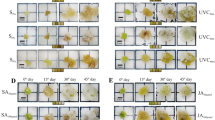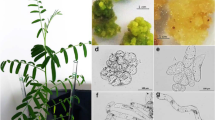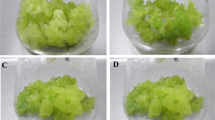Abstract
Cereus hildmannianus is an ornamental plant with various food and medicinal applications. Plant biotechnology is an attractive approach for metabolite production under controlled conditions, and elicitation is considered a highly effective strategy for increasing the production of bioactive compounds. The present study investigated the effects of the elicitors, sucrose (0.03–0.23 mol), salicylic (50–200 µmol) and jasmonic acids (50–200 µmol) on fatty acid (FA) production in callus cultures of C. hildmannianus. Gas chromatography (GC) coupled with mass spectrometry or a flame ionization detector were used to determine the FA profiles of callus directly or of their extracts. Furthermore, cytotoxic activity of the extracts was evaluated. In total, 30 FA were identified; the highest numbers and concentrations of FA were observed following the direct esterification of the samples of callus that had been induced with 0.06 mol of sucrose (Suc0.06), followed by those that had been induced with 50 µmol of salicylic acid (Sa50) and 150 µmol of jasmonic acid (Ja150). In the analysis of the extracts, the greatest elicitation effect was observed in those of callus elicited with 0.06 mol of sucrose (Suc0.06E), where the production of 19 FA was increased, followed by those from the 50 µmol of salicylic acid treatment (Sa50E). In particular, the myristoleic (0.22 mg g− 1 dry weight [DW], Suc0.06E), palmitic (7.66 and 2.77 mg g− 1 DW for Suc0.06E and Sa50E), linoleic (1.97 and 1.05 mg g− 1 DW for Suc0.06E and Sa50E), α-linolenic (0.16 mg g− 1 DW, Suc0.06E), oleic (0.11 mg g− 1 DW, Suc0.06E), and arachidonic acids (3.88 and 1.59 mg g− 1 DW for Suc0.06E and Sa50E) can be highlighted. The highest cytotoxic activity (CC50) against CaCo-2 tumor cells was achieved with Sa50E (261 µg mL− 1), Ja150E (263 µg mL− 1), and Suc0.06E (367 µg mL− 1) in comparison with that of non-elicited callus extracts (NECE; 516 µg mL− 1), which resulted in an improved selectivity index (SI) towards these cells over non-tumor cells (0.45 for NECE, 0.96 for Sa50E, and 1.10 for Ja150E). In summary, the elicitors were able to alter the production of FA in callus cultures of C. hildmannianus and improve the cytotoxicity and SI of the extracts. These results are promising for the clean and sustainable bioproduction of bioactive FA with food and pharmaceutical applications.
Key message
Elicitation of Cereus hildmannianus callus tissues with sucrose, salicylic acid, and jasmonic acid for enhancement of fatty acids content and antitumor activity.








Similar content being viewed by others
Data availability
The authors confirm that the data supporting the findings of this study are available within the article and supplementary material.
Code availability
Not applicable.
Abbreviations
- DMEM:
-
Dulbecco’s Modified Eagle Medium
- DW:
-
Dry weight
- CaCo-2:
-
Colorectal adenocarcinoma
- CC50 :
-
Cytotoxic concentration for 50% of the cells
- FA:
-
Fatty acids
- FBS:
-
Fetal bovine serum
- GC/FID:
-
Gas chromatography coupled to a flame ionization detector
- GC/MS:
-
Gas chromatography coupled to mass spectrometry
- HaCaT:
-
Immortalized keratinocytes
- Ja:
-
Jasmonic acid
- MUFA:
-
Monounsaturated fatty acids
- MS:
-
Murashige and Skoog
- NEC(E):
-
Non-elicited callus culture (extract)
- PPFD:
-
Photosynthetic photon flux density
- PUFA:
-
Polyunsaturated fatty acids
- Suc:
-
Sucrose
- Sa:
-
Salicylic acid
- SFA:
-
Saturated fatty acids
- SI:
-
Selectivity index
- UFA:
-
Unsaturated fatty acids
References
Amjad Khan W, Chun-Mei H, Khan N, Iqbal A, Lyu S-W, Shah F (2017) Bioengineered plants can be a useful source of omega-3 fatty acids. Biomed Res Int 2017(7348919):1–9. https://doi.org/10.1155/2017/7348919
Andriamparany R, Lundberg J, Pyykönen M, Wurz S, Elmqvist T (2020) The effect of introduced Opuntia (Cactaceae) species on landscape connectivity and ecosystem service provision in southern Madagascar. In: Gasparatos A, Naidoo M, Ahmed A, Karanja A, Fukushi K, Saito O, Takeuchi K (eds) Sustainability challenges in Sub-saharan Africa II: insights from Eastern and Southern Africa. Springer Singapore, Singapore, pp 145–166
Areche C, Hernandez M, Cano T, Ticona J, Cortes C, Simirgiotis M, Caceres F, Borquez J, Echeverría J, Sepulveda B (2020) Corryocactus brevistylus (K. Schum. Ex Vaupel) Britton & Rose (Cactaceae): antioxidant, gastroprotective effects, and metabolomic profiling by ultrahigh-pressure liquid chromatography and electrospray high resolution orbitrap tandem mass spectrometry. Front Pharmacol 11:1–12. https://doi.org/10.3389/fphar.2020.00417
Becker R, Ri LD, Farias-Singer R, Singer RB (2021) Unveiling the germination requirements for Cereus hildmannianus (Cactaceae), a potential new crop from southern and southeastern Brazil. Acta Bot Bras 34:765–771. https://doi.org/10.1590/0102-33062020abb0263
Bouzroud S, El Maaiden E, Sobeh M, Merghoub N, Boukcim H, Kouisni L, El Kharrassi Y (2023) Biotechnological approaches to Producing Natural Antioxidants: Anti-ageing and skin longevity prospects. Int J Mol Sci 24(2):1–23. https://doi.org/10.3390/ijms24021397
Carrillo Pérez C, Cavia Camarero MdM, Alonso de la Torre S (2012) Antitumor effect of oleic acid; mechanisms of action. A review. Nutr. Hosp (27):1860–1865. https://doi.org/10.3305/nh.2012.27.6.6010
Casillas-Vargas G, Ocasio-Malavé C, Medina S, Morales-Guzmán C, Del Valle RG, Carballeira NM, Sanabria-Ríos DJ (2021) Antibacterial fatty acids: an update of possible mechanisms of action and implications in the development of the next-generation of antibacterial agents. Prog Lipid Res 82:1–10. https://doi.org/10.1016/j.plipres.2021.101093
Chen Y, Chen Y, Shi Y, Ma C, Wang X, Li Y, Miao Y, Chen J, Li X (2016) Antitumor activity of Annona squamosa seed oil. J Ethnopharmacol 193:362–367. https://doi.org/10.1016/j.jep.2016.08.036
Chhikara BS, Parang K (2023) Global Cancer statistics 2022: the trends projection analysis. Chem Biol Lett 10(1):451–451
Corrêa A, Santos É, Gavioli A, Sassaki G, Machado M, Mangolin C, Gonçalves J, Gonçalves R, Oliveira A (2022) Cell wall polysaccharides from in vitro propagated Cereus hildmannianus K. Schum. Plants. Nat Prod Res 36(9):2424–2428. https://doi.org/10.1080/14786419.2020.1836630
D’Angelo S, Motti ML, Meccariello R (2020) ω-3 and ω-6 polyunsaturated fatty acids, obesity and cancer. Nutrients 12(9):1–22. https://doi.org/10.3390/nu12092751
Dedyukhina EG, Kamzolova SV, Vainshtein MB (2014) Arachidonic acid as an elicitor of the plant defense response to phytopathogens. Chem Biol Technol Agric 1(1):1–6. https://doi.org/10.1186/s40538-014-0018-9
Dewir Y, Chakrabarty D, Wu C, Hahn E, Jeon W, Paek K (2010) Influences of polyunsaturated fatty acids (PUFAs) on growth and secondary metabolite accumulation in Panax ginseng CA Meyer adventitious roots cultured in air-lift bioreactors. S Afr J Bot 76(2):354–358. https://doi.org/10.1016/j.sajb.2009.10.008
Fazili MA, Bashir I, Ahmad M, Yaqoob U, Geelani SN (2022) In vitro strategies for the enhancement of secondary metabolite production in plants: a review. BNRC 46(1):1–12. https://doi.org/10.1186/s42269-022-00717-z
Follador BG, da Silva Santos É, Gonçalves JE, Gonçalves RAC, de Oliveira AJB (2021) Effect of sucrose on the fatty acid metabolism of adventitious root cultures in vitro of Stevia rebaudiana. Res Soc Dev 10(10):e182101018651–e182101018651. https://doi.org/10.33448/rsd-v10i10.18651
Gamborg OLc, Miller RA, Ojima K (1968) Nutrient requirements of suspension cultures of soybean root cells. Exp Cell Res 50(1):151–158. https://doi.org/10.1016/0014-4827(68)90403-5
Goldhaber-Pasillas GD, Mustafa NR, Verpoorte R (2014) Jasmonic acid effect on the fatty acid and terpenoid indole alkaloid accumulation in cell suspension cultures of Catharanthus roseus. Molecules 19(7):10242–10260. https://doi.org/10.3390/molecules190710242
González-Fernández MJ, Ortea I, Guil-Guerrero JL (2020) α-Linolenic and γ-linolenic acids exercise differential antitumor effects on HT-29 human Colorectal cancer cells. Toxicol Res 9(4):474–483. https://doi.org/10.1093/toxres/tfaa046
Guo Z, Sun Y (2004) Solvent-free enzymatic synthesis of 1, 3‐diconjugated linoleoyl glycerol optimized by response surface methodology. Biotechnol Prog 20(2):619–622. https://doi.org/10.1021/bp034212m
Hsu M-C, Huang Y-S, Ouyang W-C (2020) Beneficial effects of omega-3 fatty acid supplementation in schizophrenia: possible mechanisms. Lipids Health Dis 19:1–17. https://doi.org/10.1186/s12944-020-01337-0
Ibrahim MM, Arafa NM, Matter MA (2015) Effect of some elicitors on chemicals composition for Nigella sativa callus cultures. World J Pharm Res 2160–2166
Iguchi K, Okumura N, Usui S, Sajiki H, Hirota K, Hirano K (2001) Myristoleic acid, a cytotoxic component in the extract from Serenoa repens, induces apoptosis and necrosis in human prostatic LNCaP cells. Prostate 47(1):59–65. https://doi.org/10.1002/pros.1047
Jacomini D, Sinzker RC, Mangolin CA, Grande PA, Nocchi SR, Nakamura CV, de Oliveira AJB, Gonçalves RAC (2015) Lipid profile and antiproliferative activity of callus cultures of Cereus peruvianus Mill. Ind Crop Prod 69:408–414. https://doi.org/10.1016/j.indcrop.2015.02.034
Jayme M, Ames F, Bersani-Amado C, Fatima PS Machado M, Mangolin CA, AC Goncalves R, JB de Oliveira A (2015) Primary characterization and evaluation of anti ulcerogenic activity of an aqueous extract from callus culture of Cereus peruvianus Mill. (Cactaceae). Curr Pharm Biotechno 16(5):462–467. https://doi.org/10.2174/1389201016666150303154342
Jenkins B, West JA, Koulman A (2015) A review of odd-chain fatty acid metabolism and the role of pentadecanoic acid (C15: 0) and heptadecanoic acid (C17: 0) in health and Disease. Molecules 20(2):2425–2444. https://doi.org/10.3390/molecules20022425
Karlik E, Ozudogru EA (2023) Production of Nutraceuticals using plant cell and tissue culture. In: Upadhyay SK, Singh SP (eds) Plants as Bioreactors for Industrial Molecules. John Wiley & Sons, Pondicherry, pp 457–484
Khan SU, Lone AN, Khan MS, Virani SS, Blumenthal RS, Nasir K, Miller M, Michos ED, Ballantyne CM, Boden WE (2021) Effect of omega-3 fatty acids on cardiovascular outcomes: a systematic review and meta-analysis. EClinicalMedicine 38:1–10. https://doi.org/10.1016/j.eclinm.2021.100997
Kumari P, Reddy C, Jha B (2011) Comparative evaluation and selection of a method for lipid and fatty acid extraction from macroalgae. Anal Biochem 415(2):134–144. https://doi.org/10.1016/j.ab.2011.04.010
Liau MC, Kim J-H, Fruehauf JP (2021) Arachidonic acid and its metabolites as surveillance differentiation inducers to protect healthy people from becoming cancer patients. Clin Pharmacol Toxicol Res 4(1):7–10
Mahalakshmi R, Eganathan P, Parida AK (2013) Salicylic acid elicitation on production of secondary metabolite by cell cultures of Jatropha curcas L. Int J Pharm Pharm Sci 5(4):655–659
Martin PG, Tavares JSdF, Mangolin CA, Machado MdFPdS (2018) Somaclones of mandacaru (Cactaceae) with high morphological divergence may generate new varieties of ornamental cacti. Ornam Hortic 24:415–423
Murashige T, Skoog F (1962) A revised medium for rapid growth and bio assays with Tobacco tissue cultures. Physiol Plant 15(3):473–497. https://doi.org/10.1111/j.1399-3054.1962.tb08052.x
Nadeem H, Ahmad F (2019) Prospects for the use of plant cell culture as alternatives to produce secondary metabolites. In: Akhtar MS, Swamy MK (eds) Natural bio-active compounds: volume 3: Biotechnology, Bioengineering, and Molecular approaches. Springer Singapore, Singapore, pp 153–182
Nakamura H, Tsujiguchi H, Kambayashi Y, Hara A, Miyagi S, Yamada Y, Nguyen TTT, Shimizu Y, Hori D, Nakamura H (2019) Relationship between saturated fatty acid intake and Hypertension and oxidative stress. Nutrition 61:8–15. https://doi.org/10.1016/j.nut.2018.10.020
Narayani M, Srivastava S (2017) Elicitation: a stimulation of stress in in vitro plant cell/tissue cultures for enhancement of secondary metabolite production. Phytochem Rev 16:1227–1252. https://doi.org/10.1007/s11101-017-9534-0
Ochoa-Velasco CE, Avila-Sosa R, Navarro-Cruz AR, López-Malo A, Palou E (2017) Biotic and abiotic factors to increase bioactive compounds in fruits and vegetables. In: Grumezescu A, Holban AM (eds) Food Bioconversion. Elsevier, Romania, pp 317–349
Oksman-Caldentey K-M, Sevón N, Vanhala L, Hiltunen R (1994) Effect of nitrogen and sucrose on the primary and secondary metabolism of transformed root cultures of Hyoscyamus muticus. Plant Cell Tissue Organ Cult 38(2):263–272. https://doi.org/10.1007/BF00033886
Oliveira SA, Machado MdFPdS, Prioli AJ, Mangolin CA (1995) In vitro propagation of Cereus peruvianus Mill. (Cactaceae). In Vitro Cell Dev Biol -Plant 31(1):47–50. https://doi.org/10.1007/BF02632226
Orešič M, Hänninen VA, Vidal-Puig A (2008) Lipidomics: a new window to biomedical frontiers. Trends Biotechnol 26(12):647–652. https://doi.org/10.1016/j.tibtech.2008.09.001
Perez-Matas E, Garcia-Perez P, Bonfill M, Lucini L, Hidalgo-Martinez D, Palazon J (2023) Impact of Elicitation on Plant antioxidants production in Taxus cell cultures. Antioxidants 12(4):1–18. https://doi.org/10.3390/antiox12040887
Ramirez-Estrada K, Vidal-Limon H, Hidalgo D, Moyano E, Golenioswki M, Cusidó RM, Palazon J (2016) Elicitation, an effective strategy for the biotechnological production of bioactive high-added value compounds in plant cell factories. Molecules 21(2):1–24. https://doi.org/10.3390/molecules21020182
Rincón-Pérez J, Rodríguez-Hernández L, Ruíz-Valdiviezo VM, Abud-Archila M, Luján-Hidalgo MC, Ruiz-Lau N, González-Mendoza D, Gutiérrez-Miceli FA (2016) Fatty acids Profile, Phenolic compounds and antioxidant capacity in Elicited Callus of Thevetia peruviana (pers.) K. Schum. J Oleo Sci 65(4):311–318. https://doi.org/10.5650/jos.ess15254
Rocha Filho RR, Santos DC, Véras AS, Siqueira MC, Monteiro CC, Mora-Luna RE, Farias LR, Santos VL, Chagas JC, Ferreira MA (2021) Miúda (Nopalea cochenillifera (L.) Salm-Dyck)—The best forage Cactus genotype for feeding lactating dairy cows in semiarid regions. Animals 11(6):1–13. https://doi.org/10.3390/ani11061774
Sanders AE, Weatherspoon ED, Ehrmann BM, Soma PS, Shaikh SR, Preisser JS, Ohrbach R, Fillingim RB, Slade GD (2022) Circulating polyunsaturated fatty acids, pressure pain thresholds, and nociplastic pain conditions. PLEFA 184:1–10. https://doi.org/10.1016/j.plefa.2022.102476
Santos PD, Silveira Rd, Reis NV, Visentainer JV, Santos OO (2018) Analytical method development for fatty acid direct methylation in fruits. J Braz Chem Soc 29:1645–1652. https://doi.org/10.21577/0103-5053.20180036
Santos ÉdS, de Oliveira AJB, da Silva MdFP, Mangolin CA, Gonçalves RAC (2021) Cereus hildmannianus (K.) Schum. (Cactaceae): Ethnomedical uses, phytochemistry and biological activities. J Ethnopharmacol 264:113339. https://doi.org/10.1016/j.jep.2020.113339
Santos ÉdS, Savam A, Cabral MRP, Castro JCC, Collet SAdO, Mandim F, Calhelha RC, Barros L, Machado MdFPdSM, Oliveira AJBd, Gonçalves RAC (2022) Low-cost alternative for the bioproduction of bioactive phenolic compounds of callus cultures from Cereus hildmannianus (K.) Schum. J Biotechnol 356:8–18. https://doi.org/10.1016/j.jbiotec.2022.07.001
Santos ÉdS, Cabral MRP, da Silva TFO, de Oliveira AJB, de Fátima Pires da Silva Machado M, Mangolin CA, Gonçalves RAC (2023) Improvement of phenolic compounds production in callus cultures of Cereus hildmannianus (K.) Schum. By elicitation. Plant Cell Tissue Organ Cult 153(1):37–51. https://doi.org/10.1007/s11240-022-02438-7
Seybold H, Trempel F, Ranf S, Scheel D, Romeis T, Lee J (2014) Ca2+ signalling in plant immune response: from pattern recognition receptors to Ca2+ decoding mechanisms. New Phytol 204(4):782–790. https://doi.org/10.1111/nph.13031
Shakya P, Marslin G, Siram K, Beerhues L, Franklin G (2019) Elicitation as a tool to improve the profiles of high-value secondary metabolites and pharmacological properties of Hypericum perforatum. J Pharm Pharmacol 71(1):70–82. https://doi.org/10.1111/jphp.12743
Souza RP, Bonfim-Mendonça PdS, Gimenes F, Ratti BA, Kaplum V, Bruschi ML, Nakamura CV, Silva SO, Maria-Engler SS, Consolaro ME (2017) Oxidative stress triggered by apigenin induces apoptosis in a comprehensive panel of human cervical cancer-derived cell lines. Oxid Med Cell Longev 2017:1–18. https://doi.org/10.1155/2017/1512745
Sung H, Ferlay J, Siegel RL, Laversanne M, Soerjomataram I, Jemal A, Bray F (2021) Global cancer statistics 2020: GLOBOCAN estimates of incidence and mortality worldwide for 36 cancers in 185 countries. CA Cancer J Clin 71(3):209–249. https://doi.org/10.3322/caac.21660
Thomas J, Thomas C, Radcliffe J, Itsiopoulos C (2015) Omega-3 fatty acids in early prevention of inflammatory neurodegenerative disease: a focus on Alzheimer’s disease. Biomed Res. Int. 2015:1–13 https://doi.org/10.1155/2015/172801
WHO WHO (2023) International Agency for Research on Cancer: Global Cancer Observatory. In. https://gco.iarc.fr/Accessed21/11/2023 2023
Wiedmer SK, Yohannes G (2012) Characterization of liposomes by FFF. In: Williams SKR, Caldwell KD (eds) Field-Flow Fractionation in Biopolymer Analysis. Springer, Vienna, pp 207–221
Wilson SA, Roberts SC (2012) Recent advances towards development and commercialization of plant cell culture processes for the synthesis of biomolecules. Plant Biotechnol J 10(3):249–268. https://doi.org/10.1111/j.1467-7652.2011.00664.x
Yeo H, Youn K, Kim M, Yun E-Y, Hwang J-S, Jeong W-S, Jun M (2013) Fatty acid composition and volatile constituents of Protaetia brevitarsis larvae. Prev Nutr Food Sci 18(2):150–156. https://doi.org/10.3746/pnf.2013.18.2.150
Zani AP, Zani CP, Din ZU, Rodrigues-Filho E, Ueda-Nakamura T, Garcia FP, de Oliveira Silva S, Nakamura CV (2023) Dibenzylideneacetone induces apoptosis in Cervical cancer cells through Ros-mediated mitochondrial damage. Antioxidants 12(2):1–34. https://doi.org/10.3390/antiox12020317
Zárate R, el Jaber-Vazdekis N, Tejera N, Pérez JA, Rodríguez C (2017) Significance of long chain polyunsaturated fatty acids in human health. Clin Transl Med 6(1):1–19. https://doi.org/10.1186/s40169-017-0153-6
Zhai X, Jia M, Chen L, Zheng C-j, Rahman K, Han T, Qin L-p (2017) The regulatory mechanism of fungal elicitor-induced secondary metabolite biosynthesis in medical plants. Crit Rev Microbiol 43(2):238–261. https://doi.org/10.1080/1040841X.2016.1201041
Zhao J, Davis LC, Verpoorte R (2005) Elicitor signal transduction leading to production of plant secondary metabolites. Biotechnol Adv 23(4):283–333. https://doi.org/10.1016/j.biotechadv.2005.01.003
Zhu S, Jiao W, Xu Y, Hou L, Li H, Shao J, Zhang X, Wang R, Kong D (2021) Palmitic acid inhibits Prostate cancer cell proliferation and Metastasis by suppressing the PI3K/Akt pathway. Life Sci 286:120046. https://doi.org/10.1016/j.lfs.2021.120046
Funding
This study was fnanced in parts by the National Council for Scientifc and Technological Development (CNPq—Conselho Nacional de Desenvolvimento Científco e Tecnológico), Coordination for the Improvement of Higher Education Personnel (CAPES—Coordenação de Aperfeiçoamento de Pessoal de Nível Superior – Brasil (CAPES – Finance Code 001)), and Fundação Araucária de Apoio ao Desenvolvimento Científico e Tecnológico do Estado do Paraná (FA).
Author information
Authors and Affiliations
Contributions
All authors approve of the version to be submitted. ÉSS, AAF, JRSF, CMT, JEG, TUN, AJBO, and RACG, performed the study and examined the experimental data. ÉSS prepared the manuscript. RACG participated in the interpretation of data and revision for important intellectual content and completed the final version of the manuscript.
Corresponding author
Ethics declarations
Conflict of interest
The authors declare no competing interests.
Ethical approval
Not applicable.
Consent to participate
Not applicable.
Consent for publication
Not applicable.
Additional information
Communicated by Wagner Campos Otoni.
Publisher’s Note
Springer Nature remains neutral with regard to jurisdictional claims in published maps and institutional affiliations.
Electronic supplementary material
Below is the link to the electronic supplementary material.
Rights and permissions
Springer Nature or its licensor (e.g. a society or other partner) holds exclusive rights to this article under a publishing agreement with the author(s) or other rightsholder(s); author self-archiving of the accepted manuscript version of this article is solely governed by the terms of such publishing agreement and applicable law.
About this article
Cite this article
da Silva Santos, É., Ferrarezi, A.A., dos Santos Filho, J.R. et al. Effects of elicitation on fatty acid bioproduction and cytotoxicity evaluation of callus cultures from Cereus hildmannianus. Plant Cell Tiss Organ Cult 156, 48 (2024). https://doi.org/10.1007/s11240-023-02676-3
Received:
Accepted:
Published:
DOI: https://doi.org/10.1007/s11240-023-02676-3




